During the twenty-three years he was shepherd of his flock, he saw Fort Worth’s Catholic population increase from fifteen families to more than four hundred, saw two academies founded and one hospital purchased, and, most visibly, saw—and oversaw—construction of the building that he called “the culmination of my life’s joys and ambitions” and that stands today as the symbol of Catholicism in Cowtown.

Jean Marie Guyot was born in 1845 near Paris. He came to America as a young man and was ordained a priest in 1870 at St. Mary’s Cathedral in Galveston. (Photo from University of Texas at Arlington Star-Telegram Collection.)
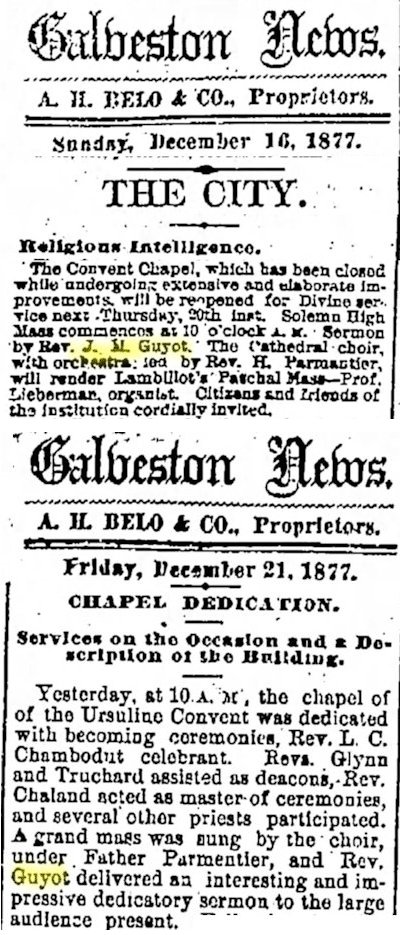 In Galveston he served at the Ursuline Convent and St. Mary’s Cathedral and was vice president of St. Mary’s University.
In Galveston he served at the Ursuline Convent and St. Mary’s Cathedral and was vice president of St. Mary’s University.
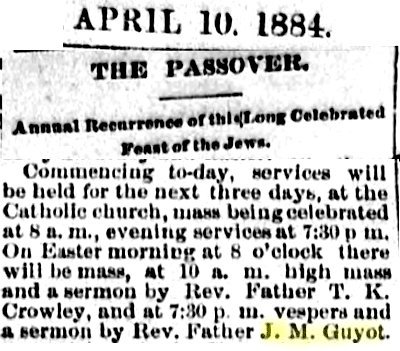
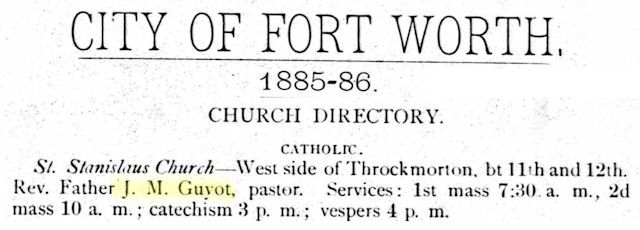 In 1884 Father Guyot came to Fort Worth to replace Father Thomas Loughrey, who in 1875 had been appointed the first resident pastor of Fort Worth’s Catholic congregation. In 1876 the congregation had built St. Stanislaus Kostka Church, named for a Polish Jesuit saint.
In 1884 Father Guyot came to Fort Worth to replace Father Thomas Loughrey, who in 1875 had been appointed the first resident pastor of Fort Worth’s Catholic congregation. In 1876 the congregation had built St. Stanislaus Kostka Church, named for a Polish Jesuit saint.
Father Guyot in his first eight years in Cowtown transformed the 1200 block of Throckmorton Street, making it the center of Catholicism in Fort Worth.
Soon after assuming his duties here, Guyot asked the Sisters of St. Mary of Namur, a Belgian order, to come to Fort Worth to teach the parish children.
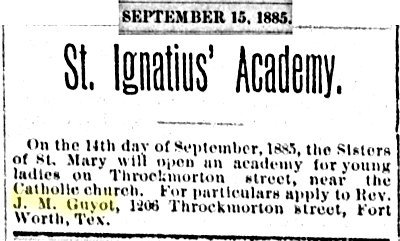 On September 14, 1885 the Sisters of St. Mary of Namur opened St. Ignatius Academy boarding school “for young ladies” at 1222 Throckmorton Street with three teachers and twenty-six students.
On September 14, 1885 the Sisters of St. Mary of Namur opened St. Ignatius Academy boarding school “for young ladies” at 1222 Throckmorton Street with three teachers and twenty-six students.
Also in 1885—one year after Guyot came to town—Fort Worth’s Catholic community was ready for a larger, grander home. Ground was broken for a new church building to be built next to St. Stanislaus Kostka Church.
 The academy prospered, and three years later the Fort Worth Gazette reported that a contract to build a new building for St. Ignatius Academy had been let.
The academy prospered, and three years later the Fort Worth Gazette reported that a contract to build a new building for St. Ignatius Academy had been let.
 In 1889 railroad baron Jay Gould, owner of the Missouri Pacific railroad, sold the railroad’s Fort Worth hospital to the Sisters of Charity of the Incarnate Word, who had been staffing the hospital since 1885. The sisters renamed the hospital “St. Joseph Infirmary.”
In 1889 railroad baron Jay Gould, owner of the Missouri Pacific railroad, sold the railroad’s Fort Worth hospital to the Sisters of Charity of the Incarnate Word, who had been staffing the hospital since 1885. The sisters renamed the hospital “St. Joseph Infirmary.”
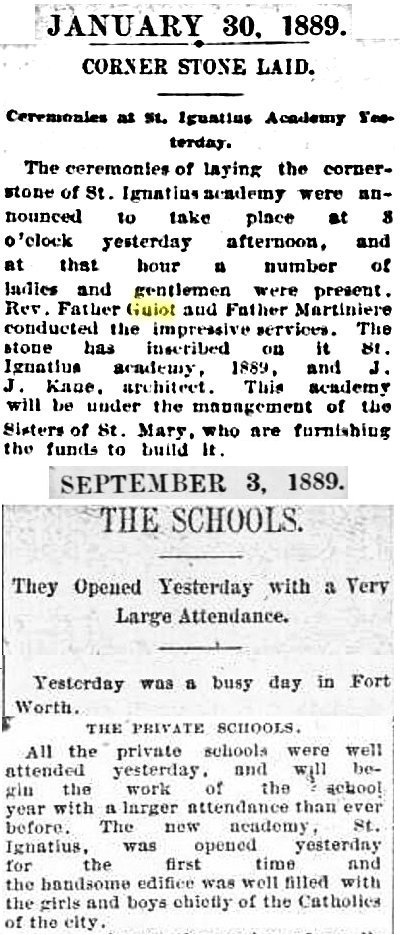
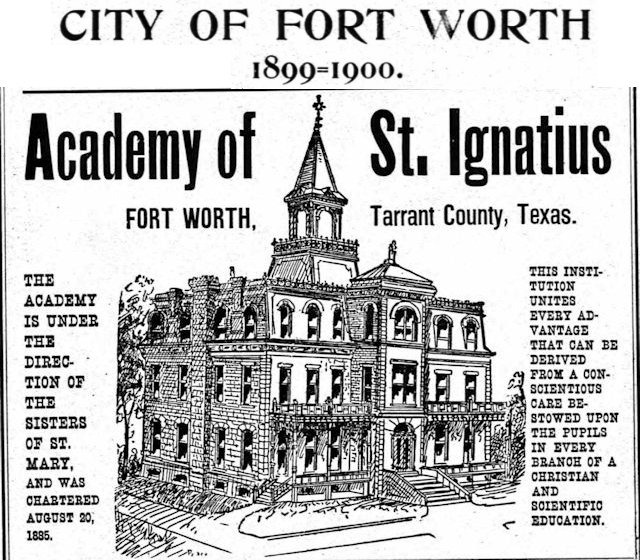 On January 29, 1889 the cornerstone of the new St. Ignatius Academy was laid. J. J. Kane, who had designed St. Joseph Infirmary, was the architect.
On January 29, 1889 the cornerstone of the new St. Ignatius Academy was laid. J. J. Kane, who had designed St. Joseph Infirmary, was the architect.
Seven months later, on September 2, 1889, St. Ignatius Academy opened in its new home. The September 3 Gazette report indicates that the school was now open to boys.
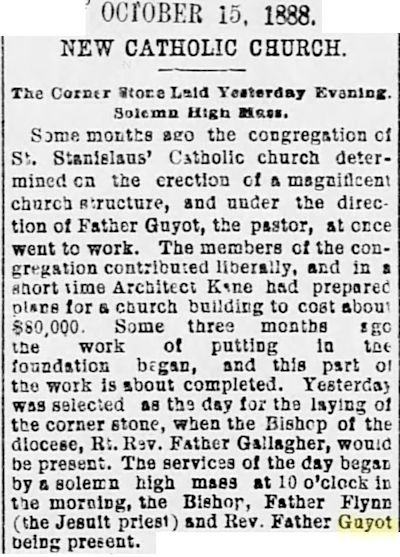 Meanwhile, on October 14, 1888 the cornerstone for the new church building was laid. Among the stone masons working on the building was Andrew Gilchrist. The architect again was J. J. Kane.
Meanwhile, on October 14, 1888 the cornerstone for the new church building was laid. Among the stone masons working on the building was Andrew Gilchrist. The architect again was J. J. Kane.
But construction progressed slowly because of a lack of funds. Father Guyot and his congregation obtained a local loan. Then Father Guyot, through European connections, obtained a $25,000 ($700,000 today) loan from a bank in Amsterdam.
Bishop Edward Dunne (as in the Dallas Catholic high school) recalled of Guyot: “He saw the first stone laid and presided at putting on the ridge on the roof. He saw to the plastering, the stained glass windows, the pews, the sanctuary with its marble altar and all of its beautiful decorations.”
 Almost four years after the cornerstone was laid, on July 10, 1892 the new church was dedicated. Father Guyot celebrated a grand high mass after the dedication. The church was named “St. Patrick” by vote of the largely Irish congregation. The church featured the first stained-glass windows in north Texas, imported from Europe.
Almost four years after the cornerstone was laid, on July 10, 1892 the new church was dedicated. Father Guyot celebrated a grand high mass after the dedication. The church was named “St. Patrick” by vote of the largely Irish congregation. The church featured the first stained-glass windows in north Texas, imported from Europe.
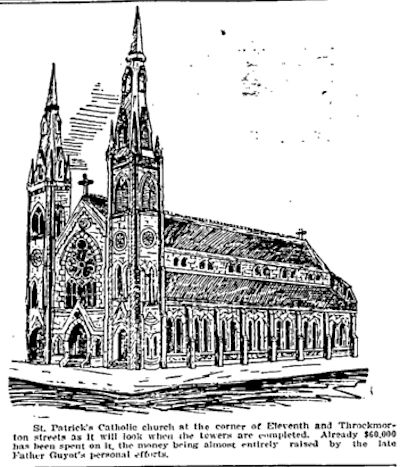 The building was not completely finished when it was dedicated. Architect Kane’s plan called for the building to have spires at the two front corners. But the financial panic of 1893—which also slowed development of Arlington Heights—kept the congregation from building the spires.
The building was not completely finished when it was dedicated. Architect Kane’s plan called for the building to have spires at the two front corners. But the financial panic of 1893—which also slowed development of Arlington Heights—kept the congregation from building the spires.
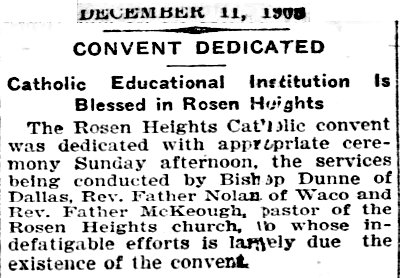 In 1905 a second Catholic academy—All Saints—opened in Rosen Heights. Father Guyot did not attend the dedication, possibly because he was already suffering the poor health that would take his life.
In 1905 a second Catholic academy—All Saints—opened in Rosen Heights. Father Guyot did not attend the dedication, possibly because he was already suffering the poor health that would take his life.
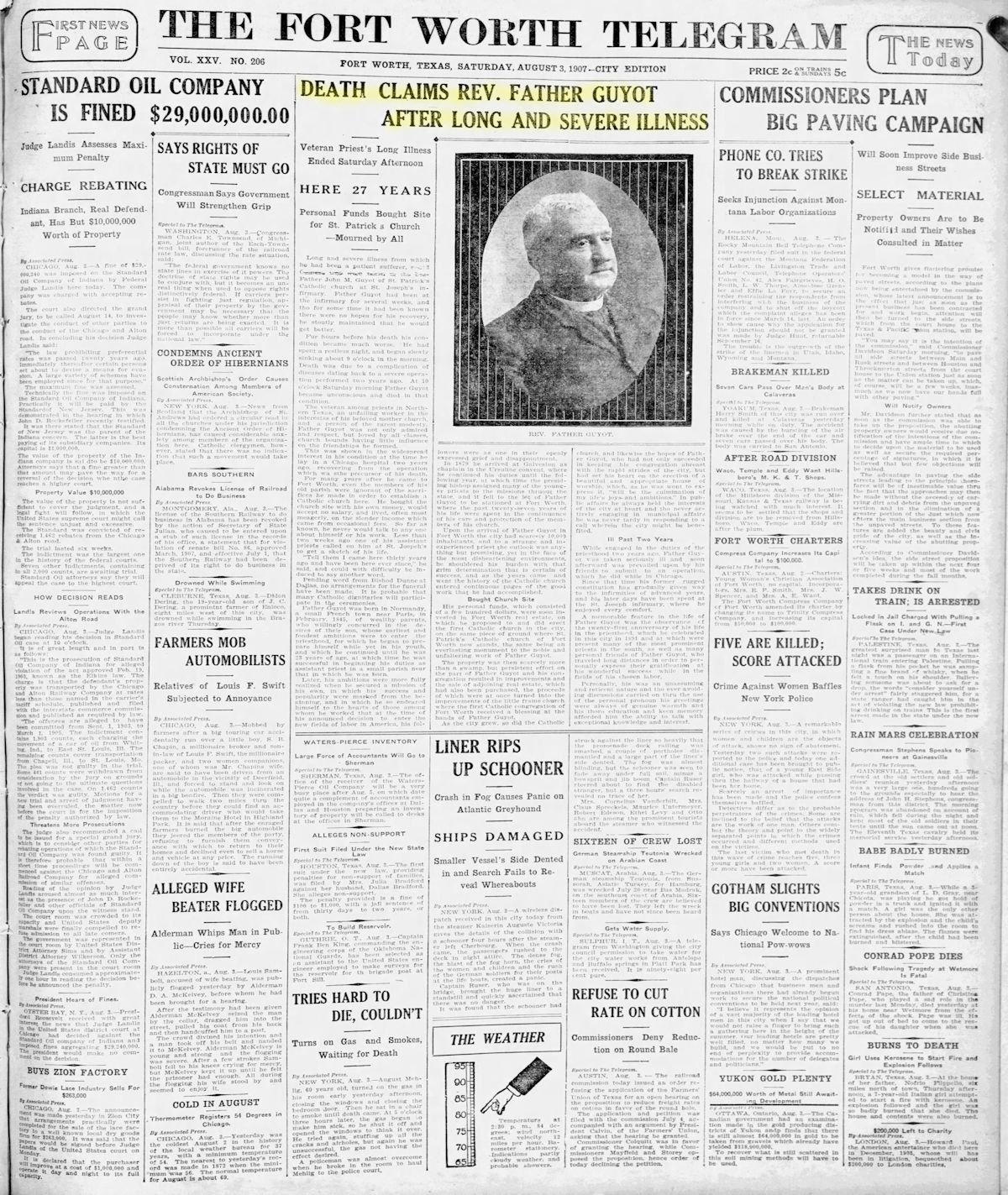 Jean Marie Guyot, Fort Worth’s second Catholic pastor, died August 3, 1907 at St. Joseph’s Hospital.
Jean Marie Guyot, Fort Worth’s second Catholic pastor, died August 3, 1907 at St. Joseph’s Hospital.
The Fort Worth Telegram called Guyot “an unfailing worker . . . of the rarest modesty.” Guyot, the newspaper wrote, had lived simply, did not accept a salary, did not like to talk about himself or his work. After his friend John Peter Smith died, Guyot had donated to the city part of the church property on which to install a bust in memory of Smith. (The “27 Years” in the headline should be “23 Years.”)
 Guyot was buried in Oakwood Cemetery and later reinterred in a crypt in basement of St. Patrick’s. (The date “August 5” on the headstone should be “August 3.”)
Guyot was buried in Oakwood Cemetery and later reinterred in a crypt in basement of St. Patrick’s. (The date “August 5” on the headstone should be “August 3.”)
The rest of the story:
 In January 1908 Father Robert Michael Nolan replaced Jean Marie Guyot as pastor of St. Patrick’s.
In January 1908 Father Robert Michael Nolan replaced Jean Marie Guyot as pastor of St. Patrick’s.
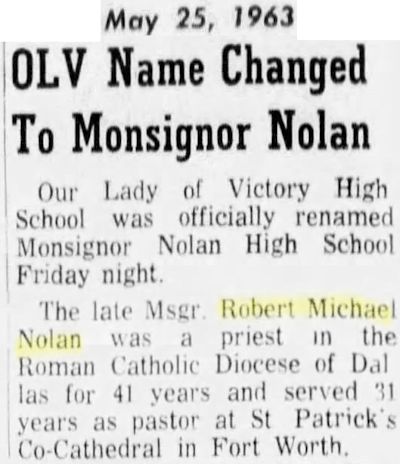 In 1963 Our Lady of Victory High School was renamed for Father Nolan.
In 1963 Our Lady of Victory High School was renamed for Father Nolan.
St. Patrick Church was elevated to the status of co-cathedral in 1953 and to the status of cathedral in 1969.






Mike, Today’s column about a well-known Ft. Worth person made me think about a couple that was not wealthy, famous, or well-known, but I wonder if you might remember them. They were a couple who were always near the corner near Zales’ Jewelry, where my mom worked. He was blind and she seemed disabled. She sang and he played the guitar (at least that is how I remember it)….just wondering if you remembered them?
Ann, that sounds like Herman and Sylvia Douglas, who I remember from outside Leonard’s.